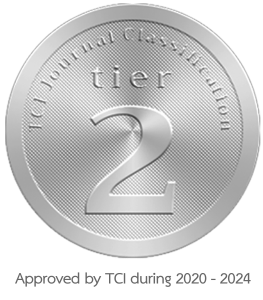Effective English Speaking and Writing Strategies of Chinese Working Staff
DOI:
https://doi.org/10.14456/jel.2023.17Keywords:
Chinese working staff, Effective English speaking strategies, Effective writing strategiesAbstract
The purposes of this study were to 1) investigate the effective English speaking and writing strategies of Chinese working staff, and 2) compare the effective strategies of participants with different genders, and ages. The participants were 92 working staff at Dongming Administrative Service Management Center, Dongming county, Shandong province, China. Other 4 persons, 2 males and 2 females, were interviewees. The researcher employed questionnaires and a semi-structure interview to collect the data from those officers. The findings revealed that the 15 speaking strategies and 15 writing strategies were their moderate effective strategies. Their top 3 speaking strategies were 1) telling the interlocutor to speak slowly, 2) practicing questioning and answering, and 3) expressing not understanding; while their top 3 writing strategies were 1) learning writing with correct grammar from teachers, 2) writing after models, and 3) memorizing sentence structures. When comparing those strategies by sex and age, the researcher found that the participants with different genders and ages rated those strategies moderate effective. However, their top three speaking and writing strategies were different.
References
Afnan, M. (2018). The correlation between vocabulary and speaking skill. Journal of Linguistics, Literature & Language Teaching, 4(1), 43-71. Anyaegbu, R., Ting, W., & Li, Y. (2012). Serious game motivation in an EFL classroom in Chinese primary school. Turkish Online Journal of Educational Technology-TOJET, 11(1), 154-164.Ashrafuzzaman, M., & Roy, J. (2019). Learning English through watching movies. NAEM Journal, 14(27), 6-19. Bao, J., & Sun, J. (2010). English grammatical problems of Chinese undergraduate students. English Language Teaching, 3, 48–53. Bear, D. R., Gillern, S. V., & Xu, W. (2018). Learning to spell in English by Chinese students: A cross-sectional study. TESOL International Journal, 13(1), 47-66.
Bessai, N. A. (2018). Using Oxford’s strategy inventory of language learning (SILL) to assess the strategy use of a group of first and third year EFL Algerian university students. American Scientific Research Journal for Engineering, Technology, and Sciences (ASRJETS) (2018), 42(1), 166-187. Bowker, L. (2020). Chinese speakers’ use of machine translation as an aid for scholarly writing in English: A review of the literature and a report on a pilot workshop on machine translation literacy. Asia Pacific Translation and Intercultural Studies. Ottawa: Canada.Dazhi, L. (2016). Strategies for developing dialogue teaching in primary English. Education and Teaching Forum, 267-268. English Engine. (2019).How watching movie can improve your English.https://www.linkedin.com/pulse/how-watching-movies-can -improve-your -english-english-engineGalloway, N., & Numajiri, T. (2019). Global English language teaching: Bottom-up curriculum implementation. TESOL Quarterly,54(1), 118-145. Goh, C. C. M. & Foong, K. P. (1997). Chinese ESL students’ learning strategies: A look at frequency, proficiency, and gender. HongKong Journal of Applied Linguistics, 2(1), 39- 53. Hayaraman, S., & Worasurt, R. (2020). A study on speaking strategies and how to improve speaking confidence among aviation students. International Journal of Arts Humanities and Social Sciences Studies, 5(4), 1-9. Hu, G. W., & Chen, B. (2007). A protocol-based study of university-level Chinese EFL learners’ writing strategies. English Australia Journal, 23(2), 37-35. Johnson, K. (2001). An introduction to foreign language learning and teaching. Pearson.Juan, W. X., & Abidin, M. J. Z. (2013). English listening comprehension problems of students from China learning English in Malaysia. Lang. India13, 14009–14022. Krejic, R. V ., & Morgan, D. W. (1970). Determining sample size for research activities. In Educational and Psychological Measurement, 30, 607- 610. Larena, C. D. (2011). Exploring knowledge of English speaking strategies in 8th and 12thgraders. PROFILE, 13(2), 85-89. Li, Z. (2020 April 27). English education in China: An evolutionary perspective. People’s Daily Online. http://en.people.cn/Liu, G. (2015). Investigating the English writing strategies used by Chinese senior high school students. Theory and Practice in Language Studies, 5(4), 844-850. Liu, N., Lin, C., & Wiley, T. G. (2016). Learner views on English language teaching in China. International Multilingual Research Journal, 10(2),137-157.Mangal, S. K., & Mangal, U. (2009). Essentials of educational technology. PHI Learning Private Limited.Mongillo, G. (2008). Play, games, and attitude: Student and teacher perspectives of educational games. Journal of Educational Technology, 5(2), 44- 54. Oxford, R. (1992).Language learning strategies: What every teacher should know. Heinle & Heinle Publishers.Nation, P. (2004). Vocabulary learning and intensive reading. EA Journal, 21(2), 20-29
Prastyo, H. (2015). The implementation of grammar translation method (GMT) and communicative language teaching (CLT) in teaching integrated English.Indonesian EFL Journal, 1(2), 170-182.Qiu, J. (2017). The effect of English movies on college English listening teaching. Theory and practice in language studies, 7(11), 1011-1024. Raheem, B. R., Anjum, F., & Ghafar, Z. N. (2023). Exploring the profound impact of artificial intelligence applications (Quillbot, Grammarly and ChatGPT) on English academic writing: A systematic review. International Journal of Integrative Research (IJIR), 1.1(10), 599-622. Ridhuan, M., & Abdullah, T. L. (2009). The writing strategies used by engineering ESL Malay learners. Conference of the International Journal of Arts &Sciences.https://www.researchgate.net/profile/Muhammad-Ridhuan/publication/266455318 Vygotsky, L. S. (1978). Mind in society: The development of higher psychological processes. Harvard University Press. Wang, L., & Fan, J. (2015). Listening difficulties of low-proficiency EFL learners: Acomparison of teacher and learner perspectives. Asian EFL J.Q,17, 85–110. Wickham, R. (2023). How to teach English to Chinese students: Linguistic challenges and best classroom strategies. https://www.fluent.com/blog/educator-english/teaching-english-to-chinese=spekersZue, W.(2018). Using games to teach English in Chinese high school classroom. Master’s Projects and Capstones. 873. https://repository.usfca.edu/capstone/873.



















